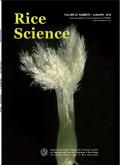Effect of Hydroponically Supplied Selenium Forms on Cadmium and Nickel Accumulation in Rice
IF 6.1
2区 农林科学
Q1 AGRONOMY
引用次数: 0
Abstract
Rice (Oryza sativa L.) farmers face challenges with metal accumulation in grain, with nickel (Ni) recently emerging as a concern due to its potential to exceed legal limits, alongside cadmium (Cd). Information on Ni behaviour and its interaction with Cd remains limited. Selenium (Se) is commonly used for rice biofortification and can reduce the accumulation of toxic metals in plants. Therefore, this study investigates how Ni and Cd influence mutual accumulation in rice and examines the impact of different Se forms on their interactions. Plants were grown hydroponically with various combinations of Cd (5 or 20 μmol/L), Ni (20 μmol/L), and Se (5 μmol/L) as selenate (Se6+) or selenite (Se4+) for 7 d. Plant growth, lipid peroxidation, and element accumulation were measured, and the distribution of Se and Ni in tissues was assayed using synchrotron-based μXRF 2D imaging. Cd and Ni were toxic to rice, reducing leaf and root biomass by 40%‒50% and inducing oxidative stress. However, their combined presence did not further exacerbate leaf growth reduction. Cd reduced root Ni accumulation by approximately 50% at equimolar concentrations, likely due to competitive inhibition at shared transport sites. Se promoted root growth in the presence of Ni and low Cd, suggesting an antioxidant role in mitigating metal-induced stress. However, high doses of Ni and Cd together significantly reduced Se accumulation (by 60% and 77% for Se4+ in roots and Se6+ in leaves, respectively) and caused severe oxidative stress in the presence of Se4+. The effectiveness of Se biofortification varied depending on the Se form: Se6+ was more effective at reducing Ni accumulation, while Se4+ effectively reduced Cd accumulation (by 45%‒75%) at low concentrations and Ni accumulation in the absence of Cd (by 50%). In conclusion, this study demonstrates that Se can mitigate Cd and Ni accumulation in rice. However, the co-presence of Cd and Ni may compromise Se enrichment in rice, highlighting the complexity of their interactions.
水培硒对水稻镉、镍积累的影响
水稻(Oryza sativa L.)农民面临着谷物中金属积累的挑战,镍(Ni)和镉(Cd)最近因其可能超过法定限制而成为人们关注的问题。关于Ni行为及其与Cd相互作用的信息仍然有限。硒(Se)通常用于水稻生物强化,可以减少植物中有毒金属的积累。因此,本研究探讨了Ni和Cd如何影响水稻的相互积累,并考察了不同形式的Se对它们相互作用的影响。以不同浓度的Cd(5或20 μmol/L)、Ni (20 μmol/L)和Se (5 μmol/L)分别作为硒酸盐(Se6+)和亚硒酸盐(Se4+)进行水培培养7 d,测定植株生长、脂质过氧化和元素积累情况,并利用同步加速器的μXRF二维成像技术检测Se和Ni在组织中的分布。镉和镍对水稻有毒害作用,可使叶片和根系生物量减少40% ~ 50%,并引起氧化胁迫。然而,它们的联合存在并没有进一步加剧叶片生长的减少。Cd在等摩尔浓度下使根Ni积累减少了约50%,可能是由于共享运输位点的竞争性抑制。硒在Ni和低Cd环境下促进根系生长,表明硒在减轻金属诱导的胁迫中具有抗氧化作用。然而,高剂量的Ni和Cd一起显著降低了Se的积累(Se4+在根中的累积量分别为60%和77%,Se6+在叶中的累积量分别为77%),并在Se4+存在下引起严重的氧化应激。生物强化硒的效果因硒的形式而异:Se6+在降低Ni积累方面更有效,而Se4+在低浓度下有效降低Cd积累(45%-75%),在无Cd情况下有效降低Ni积累(50%)。综上所述,硒能减缓水稻镉和镍的积累。然而,镉和镍的共同存在可能会损害硒在水稻中的富集,突出了它们相互作用的复杂性。
本文章由计算机程序翻译,如有差异,请以英文原文为准。
求助全文
约1分钟内获得全文
求助全文
来源期刊

Rice Science
Agricultural and Biological Sciences-Agronomy and Crop Science
CiteScore
8.90
自引率
6.20%
发文量
55
审稿时长
40 weeks
期刊介绍:
Rice Science is an international research journal sponsored by China National Rice Research Institute. It publishes original research papers, review articles, as well as short communications on all aspects of rice sciences in English language. Some of the topics that may be included in each issue are: breeding and genetics, biotechnology, germplasm resources, crop management, pest management, physiology, soil and fertilizer management, ecology, cereal chemistry and post-harvest processing.
 求助内容:
求助内容: 应助结果提醒方式:
应助结果提醒方式:


